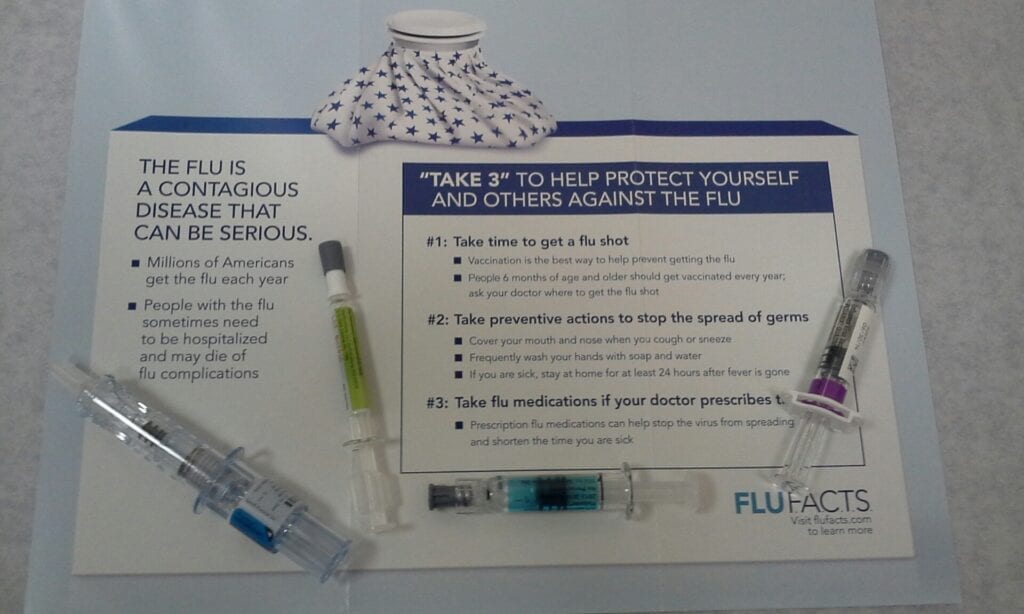Written by Linda Yau, M.D., F.A.C.P.
October 11, 2020
This year the new coronavirus that causes what can be a serious illness which is described as a “flu like” has greatly affected all of us. In a similar way, the original “flu”, influenza, has the potential to cause 20,000 preventable deaths and 200,000 hospitalizations this year. What is a flu like illness? Common symptoms include fever, body aches, fatigue, cough, and sore throat. All these symptoms are also symptoms of COVID 19, so it is impossible for healthcare workers to tell the difference between the two diseases based on the clinical scenario alone. We also are all probably aware that both influenza and COVID can worsen and require hospitalization. Patients who are older and have underlying health disorders can be at higher risk for hospitalization, development of pneumonia, and require ICU care.
Not only does the flu shot prevent getting influenza, it prevents patients getting a superinfection like pneumonia which results from the immune system being weakened by having the flu. It is also very important to get the flu shot so that you have less risk to develop symptoms that might be confused with COVID. If a patient were to call with fever, cough, sore throat and body aches, that person will need both a nasal flu test and a COVID test to differentiate between the two illnesses.
This year most of the flu shots are quadrivalent, including the high dose ones that are recommended for those over 65. Quadrivalent vaccine consists of 4 strains of influenza – the 2 predominant type A strains that we see each year in the trivalent vaccine and 2 type B strains. The second strain of B is primarily a risk for children and young adults, but it can also be passed to older adults who may care for their young grandchildren, or to those in high risk groups. The Center for Disease Control (CDC) recommends that all people 6 months and older get the flu vaccine.
The intranasal form of the flu vaccine, Flu Mist, is back to being recommended by the CDC and the American Academy of Pediatrics for flu prevention. The Flu Mist is only recommended between ages 2 to 50 and is not recommended for those with certain conditions: those with asthma, those without spleens and other life circumstances that the CDC highlights on its website. The good news for those with severe allergies to egg products is that there are non-egg formulation of flu vaccine called Flucelvax (uses a cell culture) or Flublok (uses recombinant DNA technology). Flucelvax was released in 2014 and is now available in most flu clinic locations. The Flucelvax is a cell-based quadrivalent vaccine and is available for those 4 years and older. The Flublok is also egg free since the vaccine is made using recombinant DNA technology. This website details some of the ways vaccines are manufactured.
Older adults (65+) will have a choice of the quadrivalent flu vaccine, the high-dose 65+ vaccine (Fluzone), or the Fluad vaccine. Fluzone High-Dose vaccine contains four times the amount of antigen contained in regular flu shots. The Fluad licensed in 2015 is an alternative for the 65+ group. It is not a HD of flu antigen; instead it has an added adjuvant that increases the immune response in this age group. The clinical studies on the high dose vaccine and the Fluad show higher antibody responses in this age group and we are hopeful that it will reduce the high incidence of flu in older adults. Most physicians and pharmacies do recommend the high dose flu vaccine or the Fluad for the 65+ groups, especially those with chronic debilitating diseases. There is also a vaccine available (Afluria) that does not use a needle and that uses a jet injector. It uses a high-pressure, narrow stream of fluid to penetrate the skin instead of a hypodermic needle. This is licensed for people 15-64.
The CDC and ACIP (Advisory Committee on Immunization Practices) supports all influenza vaccinations without any preference of type. Discuss with your doctor the best choice for you this year. In summary, there are many options for effective prevention of influenza. All of us should be sure to get the flu vaccine this winter season not only to reduce the risk of influenza but to also reduce the risk of needing to be tested for COVID since the symptoms of flu are the same as for COVID. And there is never a time that is “too late” to get your flu vaccine but optimal time is now in the United States, prior to the beginning of November. It takes about 2 weeks after the vaccine to get full immunity. Because influenza can cause significant illness and even death, please make time to get the vaccine. Pregnant women especially should get the injectable flu vaccine to prevent themselves and their unborn babies from severe illness. For more information on the flu vaccine, check out the CDC website: https://www.cdc.gov/flu/season/protect-your-health.html

Tags: 2020 flu season, flu vaccine

I always look forward to being enlightened by Dr. Yau’s blog.